VOL.46, NO. 1
Adaptation and Intertextuality in Abdellatif Kechiche’s Blue Is the Warmest Color (La Vie d'Adèle—Chapitres 1 et 2)
J Paul Johnson

Starring Adèle Exarchopoulos and Léa Seydoux, Abdellatif Kechiche’s controversial 2013 adaptation of Julie Maroh’s 2010 coming-of-age graphic novel Blue Is the Warmest Color may be better known for its graphic lesbian sex scenes and the post-Cannes fallout between its director and its stars than for its approach to adaptation (see Figure 1). Largely overlooked in the contentious debate over the film’s sex, stars, and shooting was much attention to the film as an adaptation, generally, or that of a graphic novel, specifically. The two versions of Blue share rough outlines of plot and character, with Kechiche preserving a number of characters, events, settings, and even occasionally some more subtle aesthetic choices such as mise-en-scène and design. Yet Kechiche’s film also takes considerable liberties in adapting Maroh’s narrative—not the least of which is changing the protagonist’s name, Clémentine, to that of her character’s portrayer, Adèle. Far more than just the sum of its sex scenes or a case study in critical controversy, Kechiche’s Blue Is the Warmest Color reflects the intertextual locus of a number of sources and influences. These include not just Maroh’s evocative sequential art but also the director’s own stated intentions and influences, including the 18th-century novel La Vie de Marianne and his cast members’, especially Exarchopoulos’s, personae. What results is far more than a simple transcription of a source but a complex work embedded in several overlapping discourses, especially those of LGBTQ people concerned about their representation onscreen but also of those in the popular press who focused their comments nearly exclusively on the film’s sex scenes and the stars’ fallout with the director. At the same time, Blue Is the Warmest Color draws upon its influences and inspirations to develop a naturalistic, subjective, and sympathetic portrait of its protagonist as she navigates a challenging transition to adulthood.
Upon the premiere of the film at Cannes in 2013, acclaim and controversy quickly followed. In a glowing review, Variety praised the stars but (more than a little erroneously) claimed that “they spend much of this three-hour emotional epic enacting the most explosively graphic lesbian sex scenes in recent memory” (Chang). Dozens of critics hotly debated the film’s sex scenes, scrutinizing Kechiche’s orientation, the stars’ performances, and the positions depicted. In a Cannes first, jury leader Steven Spielberg announced “the exceptional step of recognizing the achievements of three artists [Kechiche, Exarchopoulos, and Seydoux] in the presentation of the Palme d’Or” (qtd. in Hammond par. 3). Not unlike in the film’s coup de foudre, the harmony was short-lived, as later, the two stars complained about Kechiche's behavior and difficult conditions during the shooting. The work, they said, was physically and emotionally arduous in both the sex scenes and a fight scene. Exarchopoulos in particular, a minor and a novice to the industry, complained of feeling misled and abused by Kechiche’s direction. Both women described the experience as "horrible,” and said they would not work with Kechiche again (qtd. in Stern). Months later, both backtracked their comments, minimizing the conflicts and difficulties, but the controversy had already echoed through the trades, and even for a time, Kechiche distanced himself from the project, saying the film “should not go out,” as it was “too sullied,” referring to the negative press the film had received (qtd. in Murat & Regoulet).
Adaptation and Intertextuality
The controversies overshadowed analysis of the film’s narrative, especially as an adaptation and particularly one of a graphic novel. For decades, most scholarly discussion of adaptation focused on a relatively direct one-to-one equation between literary source and film adaptation, almost always with the realistic prose fictional novel as sole source and focusing primarily on questions of fidelity. Such an approach, historically, has elided other means of understanding a film’s often-rich network of intertextual connections and meanings. In Novel to Film, Brian MacFarlane began to deconstruct the unidirectional and narrow scope of this approach, arguing for a neoformalist criticism that would still acknowledge and scrutinize fidelity on various narrative levels, but only as a means of working towards an understanding of the many contexts and intertexts that impact adaptation. (It is from MacFarlane that I borrow most narrative terminology and methodology.) In her A Theory of Adaptation, Linda Hutcheon advocates for understanding adaptation as not just a transposition of one work into a next, but also as a “creative and interpretive act” promoting an “extended intertextual engagement with the adapted work” (8). Hutcheon’s is an attitude I aim to graft here on to McFarlane’s approach, adapted itself to account for the sequential art of Maroh’s novel, as adaptation studies today favors a postmodern approach with less privilege granted the “original” work (Olney 167-68). Recent work by Thomas Leitch, Christine Geraghty, and Julie Sanders approaches adaptation more as a process that is creative, intertextual, dynamic, and complex than as the simple product of a direct transposition.
In the case of Blue Is the Warmest Color, the film is adapted directly from a single source, but to say so is to oversimplify its relationship to the adapted work. According to Kechiche, he had in mind the basic premise for the narrative back in 2003 while directing his second feature film, L'esquive / Games of Love and Chance. At that time, the project was untitled, but it centered on the personal life and career of a female French teacher exploring her sexual identity. As Kechiche said in an interview, “I was interested in developing a female character who was passionate about her professional life and wanted to pass on her enthusiasm. At the same time this teacher had to take on the repercussions of her private life on her work—her loves, her bereavements and her break-ups.” Yet it was not until he read Maroh’s graphic novel that “the story of absolute love between two women and, at the same time, of a young woman becoming a schoolteacher” showed him how he “could link these two projects.” In this sense, the “creative act” of the adaptive process is unusual: the director-screenwriter’s vision is completed, not initiated or prompted, by reading the source. That one-to-one unidirectional understanding of adaptation MacFarlane and Hutcheon critique is in this case deconstructed by the film’s narrative origins having predated, at least conceptually, its antecedent source.
Narrative Functions: Maroh’s Graphic Novel
First published in 2010 as Le bleu est une couleur chaude, Maroh’s graphic novel was to be titled Blue Angel upon its translation to English, but rushed quickly into print in English as Blue Is the Warmest Color following the film’s 2013 triumph at Cannes. While, like the film, it also concerns the love of its young protagonist for a slightly older, blue-haired artist, its narrative structure is immediately and significantly different. In Maroh’s novel, it is Emma, the blue-haired artist, whom readers meet first, grieving the death of her former lover Clémentine, an event not at all present (or even at all implicit) in the film. In Maroh, Emma goes to the home of Clémentine's grieving parents to recover a blue diary which, we learn, provides the source of its posthumous narration. The plot then follows the action in the diary, as with only one brief analepsis to the present day Emma relives the story of their relationship, from Clémentine's teenage years and her first meeting with Emma to her untimely death and final wish. (See Appendix for a table of cardinal functions in the source novel and adapted film.)
These flashback sequences begin in a world of grey and sepia. Clémentine, a 15-year-old sophomore, develops a bit of a crush on an older male classmate, whose blue t-shirt is the only burst of color in her humdrum environment. Soon after, a second instance of the color blue appears when she finds herself aroused by a blue-haired girl crossing the street (see Figure 2); unsettled by her feelings, she initiates sex with the boy, but is dissatisfied, and experiments with kissing a girlfriend, though she feels shame and doubt when she does so.
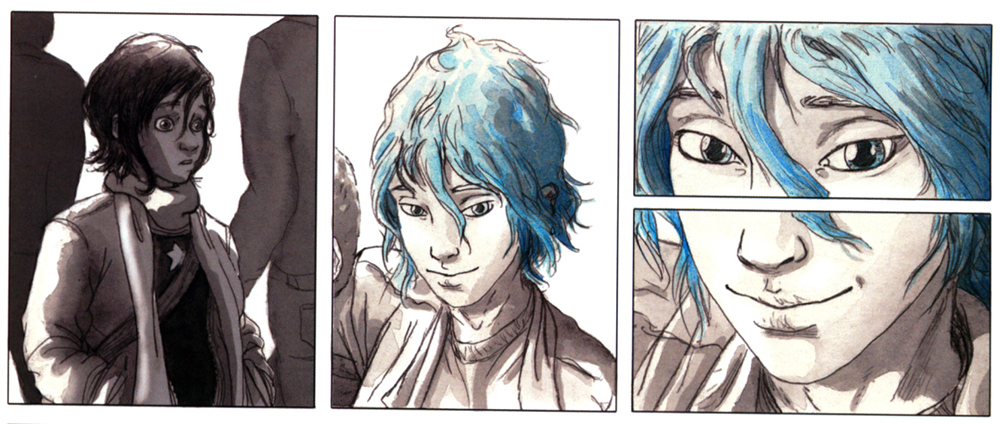
The color blue—a cyan, more specifically—appears only when Clémentine feels sexual energy, ardor, or arousal. When she follows her friend Valentin to a gay bar, she meets the blue-haired girl, Emma, and, despite Clémentine’s own reservations, she is smitten and pursues Emma romantically. The two begin a passionate but clandestine relationship interrupted by Emma’s rejections of Clémentine. In one four-page, 27-panel sequence, Maroh depicts the couple’s first sexual encounter, and, over the course of their affair as Clémentine turns 17, others more briefly. When Clémentine’s conservative parents learn of their daughter’s affair, their reactions contrast markedly with those of Emma’s parents, who embrace their daughter, her orientation, and her lover, but this contrast also signifies another: that for Emma, sexuality is overt and ideological, a stable political position confirming an established identity, while for Clémentine, it is private and emotional, a more fluid intimate expression subject to exploration and negotiation.
Those familiar with Kechiche’s film will recognize the similar cardinal functions of most of these events, at least those in Clémentine’s formative years. The events are set against a backdrop of gay pride demonstrations which Clémentine watches, from a distance and on television, as her parents dismiss and disparage the protesters. Maroh compresses ten full years of Emma’s and Clémentine’s domestic relationship in a single page, which then ends when Emma learns of Clémentine’s infidelities (see Figure 3).
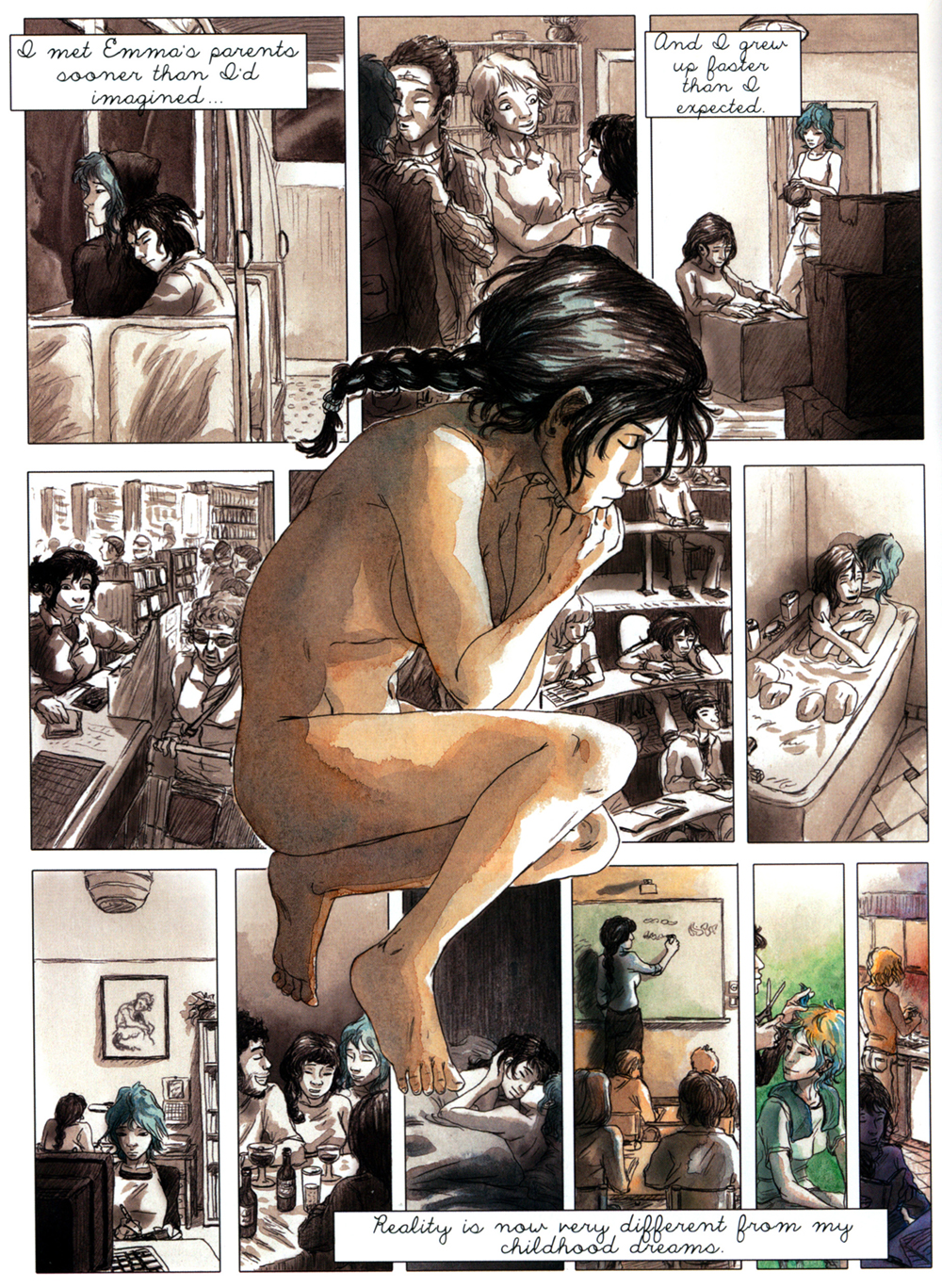
Following this revelation, the events that lead to Clémentine’s death are set in motion, and the narrative seems to turn toward melodrama in a set of reversals, reunions, catastrophes, and deathbed requests. Clémentine self-medicates to cope with Emma’s rejection, which exacerbates her depression and desperation, and when the two reconnect, a heart seizure interrupts their fragile reunion (see Figure 4). Suffering arterial pulmonary hypertension brought on by her drug addiction and stress, Clémentine is predicted to live only a few weeks. Her dying request is for a notebook in which she records her feelings for Emma, declaring that Emma saved her “from a life filled with absurd prejudice and morality” (153). Maroh’s narrative, in sum, depicts in detail both the realistic beginning and the melodramatic ending of the two’s relationship, compressing into a single page the ten years in which the two lived together.
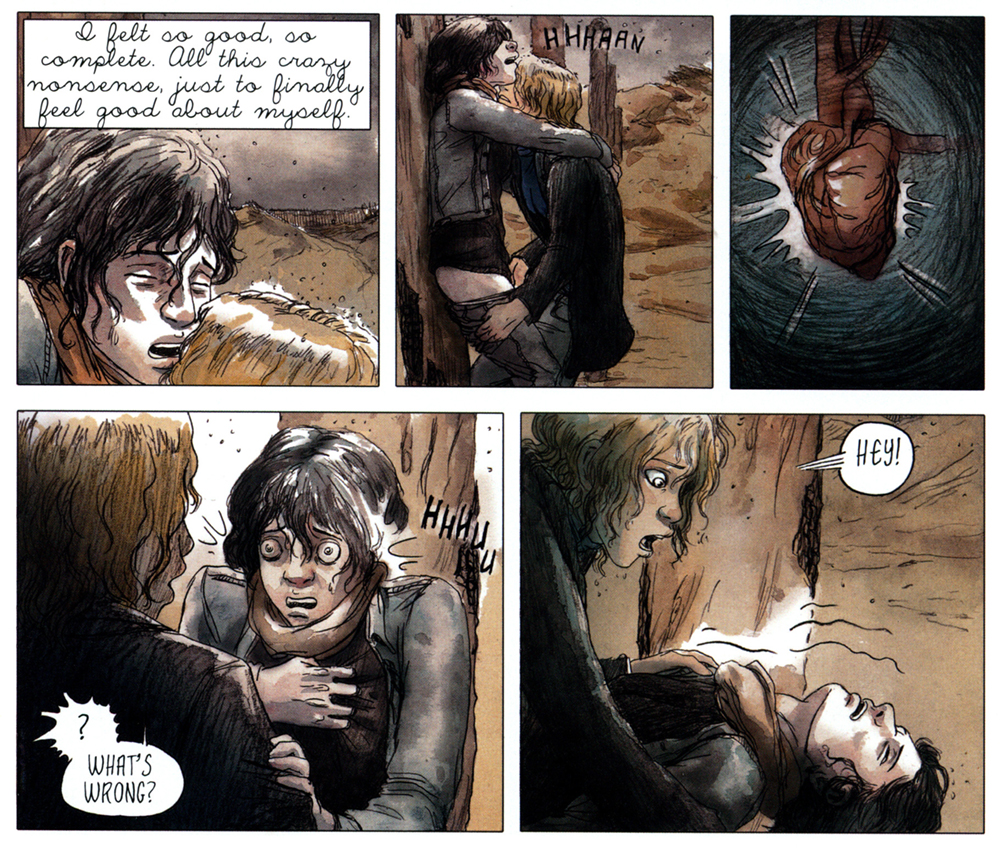
Narrative Functions: Kechiche’s Film
Much of the basic outline of Kechiche’s film is similar. In it, the protagonist, an introverted French teen named Adèle is shown dating, and then, briefly, engaging in some dissatisfying sex with a boy at her school. As in Maroh, she finds herself attracted to a blue-haired art student about whom she begins to fantasize, and Adèle begins to question her sexual identity. When later Adèle begins a relationship with Emma and a career as a schoolteacher, she finds passion and love but also ostracism and regret, as class anxieties, work pressures, and relationship conflicts take their toll on the couple. Where Maroh had elided the adult relationship between the two, compressing most of it into a single page, Kechiche explores it in some detail, affording this phase of their affair a full hour, or one-third, of the film’s running time (See Appendix).
In Kechiche’s film, the differences he had indicated in his interview—the conflicts exacerbated by differences in class and ideology—as a consequence take precedence. For instance, at a party to celebrate Emma’s artistry, Emma toasts Adèle as her muse. Emma’s friends are intellectuals, and among them Adèle is uncomfortable (see Figure 5). Afterwards, Emma tells Adèle that her diary-writing—the only reference in the film to the writing that forms the epistolary narration of Maroh’s novel—is “a waste of talent.” Adèle turns to a sexual relationship with her co-worker Antoine, is caught in a lie, and is thrown out by Emma.
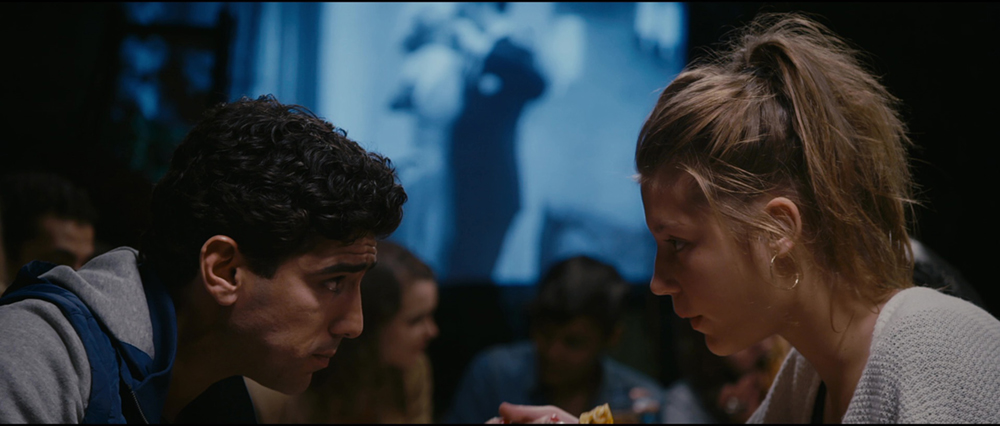
The film’s narrative concludes without any of the sudden reversals, catastrophes, or deathbed wishes of Maroh’s novel (Appendix, events 23-27), as Adèle meets Emma in a coffee shop, where they kiss and touch before leaving on reasonably good terms. At the end, Adèle attends a gallery showing of Emma’s art, including nudes of Adèle, where she is warmly welcomed, but still uncomfortable, and leaves, silently and alone, their relationship ended mutually and naturally. There is no descent into self-medication, no interrupted reconciliation, no medical emergency, no deathbed wish, and no posthumous narration of a recovered diary; instead, Adèle emerges simply as a mature young woman changed, not destroyed, by a traumatic rite of passage.
Kechiche then not only presents a significant portion of the ten-year ellipsis in Maroh’s narrative, but he also works to examine the class differences between the lovers, as his Adèle becomes muse, cook, and caregiver in an intellectually imbalanced relationship. Kechiche’s film is not an epistolary tale told in flashback from beyond the grave, as was Maroh’s, but instead a realistic, naturally-shot, and chronologically-ordered slice-of-life tale much in the tradition of a nouvelle vague like Francois Truffaut’s Les quatre cents coups or the middle sequence lovers’ talk in Jean-Luc Godard’s A bout de souffle. Kechiche favors location shooting, natural high-key lighting, hand-held camerawork, and a loose, nearly unscripted, improvisational feeling in most scenes, typically allowing the camera to linger on Adèle, often silently or in hesitation. Where in Maroh’s novel a sudden medical emergency, precipitated by prescription pill abuse, stress, and sexual excitement interrupts a potential reconciliation between the two lovers, in Kechiche’s film the climax is nearly completely devoid of melodramatic excess, and both women seem to acknowledge that their relationship has reached its natural conclusion.
In the process of adaptation, there is no such thing as an absolutely literal transcription of a source text. There is nothing particularly unusual about Kechiche’s jettisoning of what MacFarlane calls the “narrational mode” (15) of the source text—i.e. Clémentine’s posthumous epistolary narration of her and Emma’s love affair. Indeed, abandoning such intensely subjective literary points-of-view has been a staple of novel-to-film adaptation in dozens, if not scores, of works, with Milos Forman’s adaptation of Ken Kesey’s One Flew over the Cuckoo’s Nest perhaps the most famous (or infamous) example. As MacFarlane notes, “While cinema may be more agile and flexible in changing the physical point of view from which an event or object is seen, it is much less amenable to the presentation of a consistent psychological viewpoint derived from one character” (16). Kechiche’s cinematic choices, however, are aimed at presenting an intense subjectivity from his character Adèle’s perspective, one that is analogous to, if not the same as, the narrational mode employed by Maroh: Adèle is present in every scene, if not necessarily every shot, in the film; most scenes begin and end with Adèle in frame, establishing her location and her centrality to the narrative; and frequently the camera will linger for eight to twelve seconds on close-ups and medium close-ups of her as she contemplates or ponders silently. Cumulatively, these choices reinforce a mode of intense first-person subjectivity that adapt and alter Maroh’s narrational mode into something different yet similar. Kechiche’s Adele is, perhaps as much as any film can be, the single character whose psychological viewpoint is expressed consistently.
Influence and Intertextuality
From the start of the film—perhaps even with its title card, La vie d'Adèle - Chapitres 1 & 2, which names and focuses on a single character, rather than the more abstract expression of Maroh’s title—Kechiche seems far more interested in the emotional and psychological development of Adèle than that of Emma. In his film, in stark contrast to Maroh’s novel, it is Adèle whom readers first meet and last leave. Furthermore, as Cristina Stovajana notes, Kechiche’s slow pace and minute detail indicate the influences of the French literary subgenre of marivaudage, a term referencing the work of the 18th-century French writer Pierre de Marivaux, whose play Le Jeu de l'amour et du hasard was central to the director’s earlier L'Esquive. A term broadly associated with excesses of verbiage and emotion, in Marivaux’s later prose novels it came to represent a “meticulous descriptions of characters, their environment, and their thoughts, conveyed either by the author or in a direct dialogue” that can juxtapose the metaphysical with the trivial (Stojanova 7).
Kechiche’s appropriation of marivaudage is highlighted in the film’s opening scene, on the surface an everyday classroom experience. Again, his focus is on Adèle, not Emma. Kechiche’s Blue begins in Adèle’s high-school literature class, where her schoolmates distractedly read from Marivaux’s La Vie de Marianne, their delivery flat and uninspired, more than a few of them flirting and giggling through the lesson, and of them only Adèle appearing invested (see Figure 6). One student reads “My heart was missing something, and I did not know what it was,” followed by reaction shots of Adèle, unlike her distracted, insincere, and superficial classmates, deeply pondering its meaning. Subsequent scenes show Adèle describing the book as “amazing” and characterizing her as intuitive, intelligent, and mature for her age. The disappointment she finds in sex with her classmate Tomas serves only to reinforce the fact that she “did not (yet) know what her heart was missing.” That the content and style of Marivaux, rather than Maroh, informs the film’s first act is evidence of the film’s complex intertextuality. (Maroh includes a brief school scene, but set only in hallways and lunchrooms, and her Clémentine is seen reading, but the text is unnamed and there is no discussion of it, of reading, or intimation of her intellect, and serving only to introduce Thomas as a first crush.)
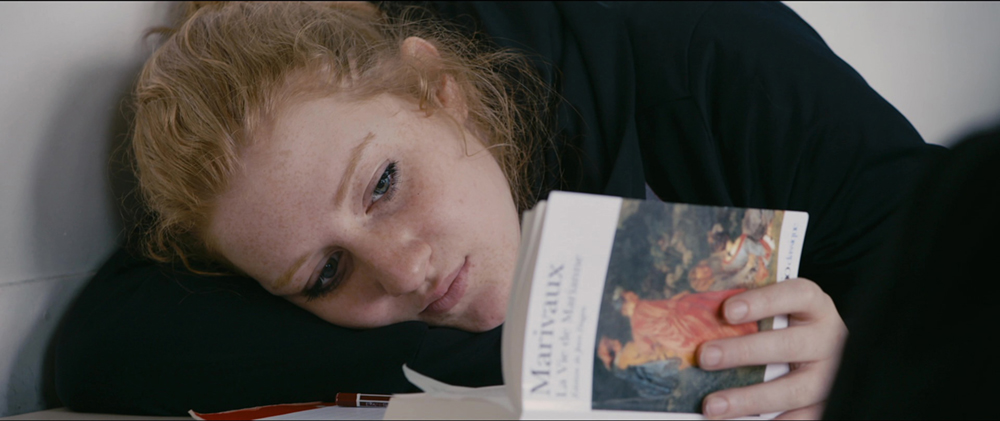
As MacFarlane observes, a film is never only an adaptation of a single source: “there is a varying, but large, segment of the audience to whom an adaptation is of no more consequence or interest as such than any other film” (21). Even the most direct of adaptations is likely to be colored by a broader network of influences than its source, and no film functions only as an adaptation of its source.
Is Blue the Warmest Color?
While Kechiche’s film takes considerable liberties and evidences multiple influences in adapting Maroh’s narrative, his Blue Is the Warmest Color nonetheless preserves a number of scenes, settings, perspectives, and subtle aesthetic choices in regards to mise-en-scène and design. So too is the case with the film’s design, in its adaptation of the more expressive strategies of the book, those MacFarlane (though he did not discuss or consider graphic novels or any form of sequential art) would call a part of its narrational mode, including its style. Maroh’s novel is a touching, tender tale of young love and loss, with exquisite drawing, considerable passion, and intense emotion. Its primary stylistic device is prevalent in its title and on nearly every page: its use of (or in some instances its lack of) the color blue. The title phrase “blue is the warmest color” is a quotation from a letter Clémentine has written to Emma, dedicating to her her blue diary, the one that will form the epistolary narrative constituting most of the book’s narrative. The phrase juxtaposes a cultural understanding of blue as a cool color with Clémentine’s claiming for herself its own oppositional meaning as one that is hot, or warm, expressive of passion rather than restraint. As the events of Clémentine’s diary are recounted, only when she is piqued or aroused—first by Thomas, then by Emma in a wet dream (see Figure 7), and later by Emma herself—does the color blue appear. In the near-absence of other colors, the color blue becomes a robust visual metaphor charged with meaning, first for ardor and then for a passionate, mature love, signaling Clémentine’s ability to determine for herself her own interests and desires despite societal expectation and parental concern.
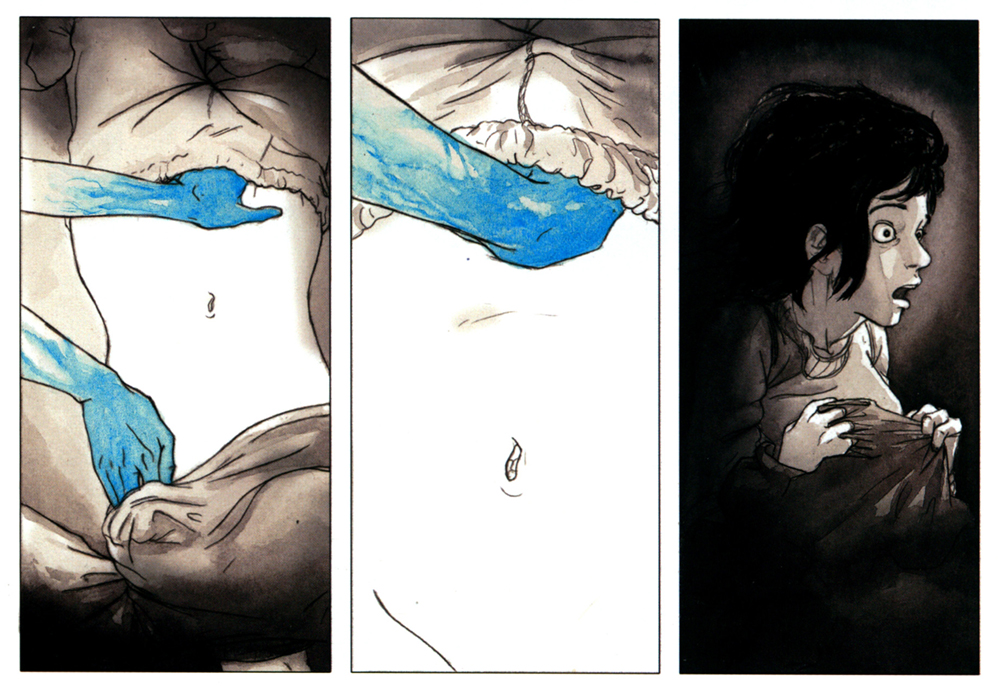
In Kechiche’s film, the color blue functions quite differently. There is no sepia-toned palette against which it stands, and its hue is closer to denim, azure, or navy than cyan. Although the title Blue Is the Warmest Color is the film’s release title only in English-speaking countries, it was in its native France titled as La Vie d'Adèle – Chapitres 1 & 2 (and Kechiche has allowed as how he might like to explore sequels, à la Truffaut’s Antoine Doinel, in subsequent films, though that was before Exarchopolous and Seydoux aired their complaints about the director). While Maroh is careful to align the color’s presence with Clémentine’s developing love and passion for Emma, in Kechiche the color is omnipresent throughout the film—it’s not just in Emma’s hair and eyes but nearly everywhere from the very first scenes: on the walls of her school, her classmates’ sweatshirts, from schoolbags and jackets and bus benches to Adèle’s schoolmates’ jewelry and nail polish, to canned smoke puffs and café walls, her bedsheets, and, in the couple’s later years, Emma’s portrait of Adèle and even Adèle’s own elementary classroom. Its presence precedes Emma’s in Adèle’s life and continues extant after she has left it (see Figure 8). That the color is omnipresent through the film diffuses its powerful metaphoric meaning as seen in Maroh. Kechiche’s blue, in contrast to Maroh’s, is everywhere, and as a consequence, signifies little more than Adèle’s powerful sexual and passionate desires, perhaps intensified by, but not in any way limited to, Emma’s presence. Here is an example of a visual motif Kechiche has borrowed—adapted—from Maroh, but in the process of doing so the specific associative meaning developed so carefully in the source novel becomes lost.
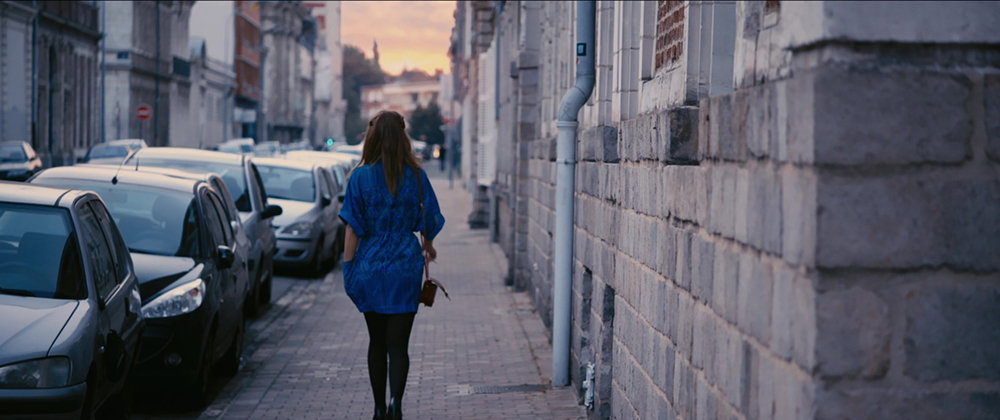
Depicting Sexuality
These kinds of questions of narrative, adaptation, influence, and intertextuality simply did not seem to register much with most of the critics discussing the film. Instead, the discourses surrounding the film focused more on its explicit—and for some, simply unconvincing—depiction of lesbian sexuality, in particular the six-minute scene of Adèle’s and Emma’s first lovemaking. That Kechiche is heterosexual opened him up to criticism from those who saw his direction of these scenes as essentially untrue to the lived experience of lesbian women and instead depicting a male heterosexual fantasy played out on the palette of the director’s set. The scenes in sum total only about nine minutes of the film’s 179-minute running time (a scant five percent), but they seem filmed in an entirely different method than the rest of the film. Where elsewhere Kechiche employs naturalistic lighting and handheld cameras, the sex scenes are the only ones that display key lighting that is artificial, mannered blocking and staging, and a mise-en-scène that sometimes excludes any element other than the stars’ bodies and the blue bedsheets. Additionally, this scene may be the only one in the film’s three-hour running time that does not work to preserve Adele’s as the central subjective perspective.
In Maroh’s novel, however, the sex scenes, like most of the framed narrative, are guided by Emma’s reading of Clémentine’s diary; they are guided by Clémentine’s posthumous narration, presented in seven to ten panels per page, and, save for one or two panels, cut in close-up details of hands, breasts, and faces (see Figure 9).
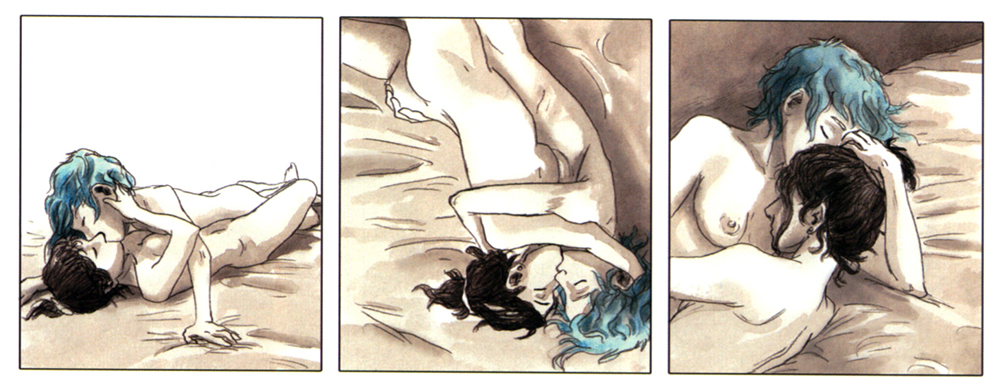
Kechiche’s film, in contrast, frames whole bodies in longer shots and takes, if such a comparison can be made, and without any specific narrative perspective other than that of a camera oddly proximate to its subjects (see Figure 10). A number of critics were quick to accuse Kechiche of heteronormative fantasizing. In Sight and Sound, Sophie Mayer claimed that Kechiche essentially silenced the voice of the lesbian writer-artist, Maroh, replacing it with his own male gaze, one that objectified the characters and stars both. Maroh, who praised most aspects of the film, criticized Kechiche’s direction of the sex scenes, calling them “brutal and surgical lesbian sex turned into porn” and adding that “as a feminist and lesbian spectator, I cannot endorse the direction Kechiche took on these matters” (“Le bleu d’Adèle”)—comments that were quoted in dozens of critical articles on the film.
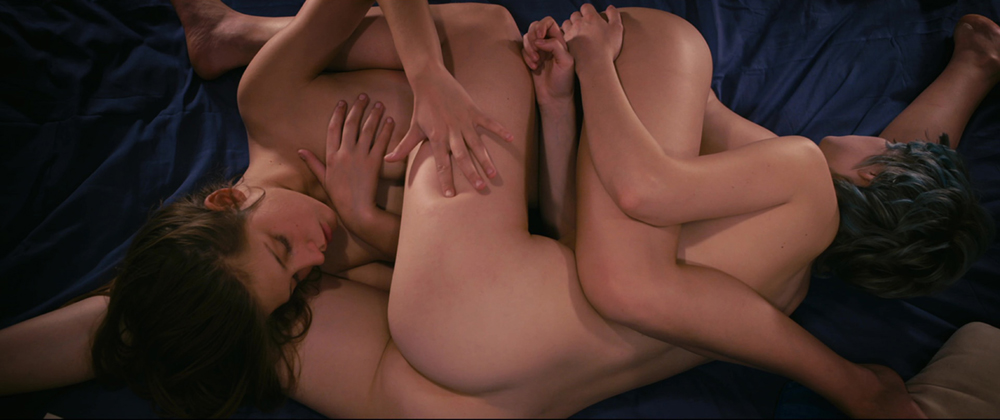
As contentious as this discussion became, its value may be that in the adaptation of the film new awareness arose of the perspectives of lesbians on their own representations by heterosexuals.
In his review of the film, Richard Corliss asks a pointed question: Instead of wondering about the nine minutes of sex in Blue, he writes, “one might ask why there is so little [sex] in most other movies.” Linda Williams suggests that “sexual content should probably be irrelevant” but that “Americans especially have a hard time separating relatively explicit sex in movies from what seems to be the totally explicit sex of pornography” (9). Certainly, the Hollywood Production Code and following it, the arbitrary, capricious, and heteronormative (and heteronormatizing) MPAA rating system, has been curiously reliant on a set of rules for the portrayal of sex and insensitive to matters of character development, in particular those of LGBTQ characters. Any film depicting sex explicitly, for any length of time, and especially of any non-heterosexual persuasion, will pose a problem for the MPAA and the American viewer—but will also engender discussion about what is, and what is not, a respectful and meaningful depiction of sexuality.
The criticism of Kechiche’s direction of the sex scenes and behavior on set towards his cast can’t—shouldn’t—be overlooked. At the same time, his Blue Is the Warmest Color’s capturing the Palme d’Or at Cannes that year was a reflection of the general acclaim with which the film was met. That it featured a few minutes of graphic lesbian sex seemed to dominate any discussion about it. But as Soto-Sanfiel and Idita point out in a fascinating study, a range of audience members, from lesbian women to straight women and straight men found the film engaging, if for different reasons, ranging from idle curiosity to powerful sexual arousal; few of the respondents deemed the sex excessive, pornographic, or embarrassing to watch (Soto-Sanfiel & Idita 570-76). In the popular media, the critical controversy over the film’s sex scenes seemed to have overshadowed more nuanced debate about the film’s ability to engage—not just arouse, nor simply enrage—its viewers.
Although controversial, Kechiche’s film is far more than mere controversy: in the end, it is a powerful exploration of a young woman’s life, love, and loss, the kinds of experiences to which anyone who has ever lived, loved, or lost, might relate, regardless of their individual experience with or attitude toward sex between women. If, in the long run, the film brings greater and wider audiences to Maroh’s touching graphic novel, that is all the stronger evidence of the intertextual and symbiotic functions of adaptation. Both works co-exist, with their similar characters and plots but different perspectives and visuals, to our collective benefit as readers and viewers. If, as Ana Bento-Ribeiro claims, the cultural mainstream too often sees young women only as either good virgins or devious sexual schemers, then films (and graphic novels) like Blue Is the Warmest Color will work to deconstruct that perspective. And if, in a world where homosexuality remains criminalized in 73 countries and punishable by death in thirteen (ILGBTIA), the presence of richly drawn cinematic narratives of young people from all walks of life, especially LGBTQIAA, even when imperfect or flawed, can only help those who view such films to understand their protagonists as individual beings who deserve the same human rights and empathies as any other person, of any orientation, in any country.
Works Cited
Bento-Ribeiro, Ana. “Bodies in Transition: Girlhoods in Post-Communist Balkan Cinema.” Girlhood Studies vol. 8, no. 1, Spring 2015, pp. 10-25.
Chang, Justin. “Cannes Film Review: Blue Is the Warmest Color.” Variety 22 May 2013. http://variety.com/2013/film/markets-festivals/cannes-film-review-blue-is-the-warmest-color-1200486043/. Accessed 24 Sept. 2016.
Corliss, Richard. “Blue Is the Warmest Color: How Much Sex Is Too Much Sex?” Time 23 Oct. 2013. http://entertainment.time.com/2013/10/24/blue-is-the-warmest-color-how-much-sex-is-too-much-sex/.
Geraghty, Christine. “Foregrounding the Media: Atonement (2007) as Adaptation.” Adaptation vol. 2, no. 2, 2009, pp. 91-109.
Hammond, Justin. “Hammond On Cannes: Spielberg and Jury Award France's Sizzling, Sexy and First Gay Palme d'Or Winner; Is Oscar Next?” Deadline Awardsline 26 May 2013. http://deadline.com/2013/05/hammond-on-cannes-spielberg-and-jury-spellbound-by-frances-sizzling-sexy-and-first-gay-palme-dor-winner-is-oscar-next-508741/. Accessed 24 Sept. 2016.
Hutcheon, Linda. A Theory of Adaptation. Routledge, 2006.
International Lesbian, Gay, Bisexual, Trans and Intersex Association. ILGA Sexual Orientation Laws in the World: 2016 Overview. http://ilga.org/downloads/03_ILGA_WorldMap_ENGLISH_Overview_May2016.pdf. Accessed 24 Sept. 2016.
Kechiche, Abdellatif, director. Blue is the Warmest Color. Perf. Léa Seydoux and Adèle Exarchopoulos. Wild Bunch, 2013.
---. An interview with Abdellatif Kechiche. The Upcoming 26 May 2013. http://www.theupcoming.co.uk/2013/05/26/an-interview-with-abdellatif-kechiche-director-of-cannes-winner-blue-is-the-warmest-colour/. Accessed 24 Sept. 2016.
Leitch, Thomas. “Adaptation Studies at a Crossroads.” Adaptation vol. 1, no. 1, 2008, pp. 63-77.
MacFarlane, Brian. Novel to Film: An Introduction to the Theory of Adaptation. Oxford UP, 1995.
Maroh, Julie. “Le bleu d’Adèle.” 27 May 2013. http://www.juliemaroh.com/2013/05/27/le-bleu-dAdèle/. Accessed 24 Sept. 2016.
---. Blue Is the Warmest Color. English ed. Trans. Ivanka Hahnenberger. Arsenal Pulp, 2013.
Mayer, Sophie. Rev. of Blue is the Warmest Color. Sight & Sound Dec. 2013. http://www.bfi.org.uk/news-opinion/sight-sound-magazine/reviews-recommendations/blue-warmest-colour. Accessed 24 Sept. 2016.
Murat, Pierre, and Laurent Rigoulet. “Polémique autour de La vie d'Adèle: Abdellatif Kechiche s'explique dans Télérama. Télérama.fr Cinema 23 Sept. 2013. http://www.telerama.fr/cinema/polemique-autour-de-la-vie-d-Adèle-abdellatif-kechiche-s-explique-dans-telerama,102550.php. Accessed 24 Sept. 2016.
Olney, Ian. “Texts, Technologies, and Intertextualities: Film Adaptation in A Postmodern World.” Literature/Film Quarterly vol. 38 no. 3, 2010, pp. 166-170.
Sanders, Julie. Adaptation and Appropriation. Routledge, 2006.
Soto-Sanfiel, Maria and Ibiti, Adriana. “Lesbian Sex in Mainstream Cinema and Audience Enjoyment.” Sexuality and Culture vol. 20, no. 3, 2016, pp. 555-578.
Stern, Malcolm. “The Stars of Blue is the Warmest Color on the Riveting Lesbian Love Story.” (Interview with Léa Seydoux and Adèle Exarchopoulos). The Daily Beast 1 Sept. 2013. http://www.thedailybeast.com/articles/2013/09/01/the-stars-of-blue-is-the-warmest-color-on-the-riveting-lesbian-love-sory-and-graphic-sex-scenes.html. Accessed 24 Sept. 2016.
Stojanova, Christina. “The Female Double: Subjectivity Between Allegory, Facticity and Marivaudage.” Kinema vol. 43, Spring 2015, pp. 75-85. http://www.kinema.uwaterloo.ca/. Accessed 24 Sept. 2016.
Williams, Linda. “Cinema's Sex Acts.” Film Quarterly vol. 67, no. 4, 2014, pp. 9-25.
Appendix: Cardinal Functions in Blue Is the Warmest Color / La Vie de Adèle

Notes
* The major events of the book and film are presented as cardinal functions, or hubs, à la Barthes, via McFarlane.
* The events are presented in story-order: in Maroh, #25 is presented first and #26 third. Clémentine’s diary then provides the posthumous epistolary narration of events 1-24. In Maroh, event #19 is presented in a single page, where Kechiche examines this phase of the relationship for approximately one full hour, or a third of the film.